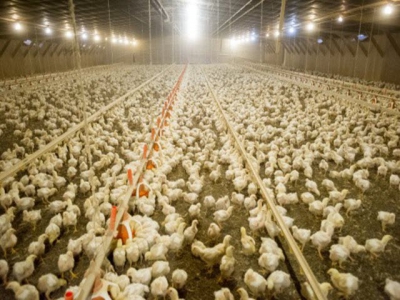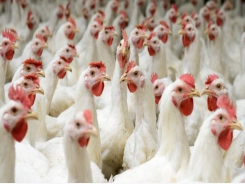Fermentation could be an inexpensive way to improve the nutritional value of novel chicken

Fermented feeds are underused in broiler nutrition, compared to practice in the pig sphere, and further research is required to exploit such feed as a viable source for chickens, concluded the authors of a newly published review.
The reviewers, Sugiharto and Samir Ranjitkar, based at the Faculty of Animal and Agricultural Sciences, Diponegoro University, in Indonesia, and Department of Animal Science, Aarhus University, in Denmark, respectively, set out to document studies looking at benefits of the use of fermented feed in broiler chicken diets.
“Feeding fermented products has been commonly practiced in the pig nutrition arena for many years (Canibe and Jensen, 2012). However, there is now increasing interest in incorporating fermented feed into broiler rations to take advantages of its positive influences, particularly on gut health and production parameters (Alshelmani et al., 2016; Zhang et al., 2016),” they wrote.
Unlike in pig nutrition, the experts said the available literature on broiler-fermented feed is still rather limited.
Their review was published in the latest edition of Animal Nutrition.
Push on for substitute feeds in poultry production
In commercial poultry, the production of broiler feed contributes up to 70% of the total production costs, and there is now a tendency in the sector to move towards alternative or unconventional feed ingredients, due to increases in global feed prices, said the reviewers.
This shift towards alternatives is, however, limited by several issues linked to certain novel raw materials such as high and low fiber and protein content and the presences of anti-nutritional factors (ANF) that can reduce feed digestibility, they said.
In terms of cost efficiencies, the authors said the desire to replace expensive conventional feedstuffs such as yellow corn in broiler diets in certain markets could further encourage the use of cheaper unconventional fermented feedstuffs in broiler nutrition.
The case for fermentation…
Some studies, they noted, have shown that fermentation increased crude protein content but decreased crude fiber content and also decreased several ANF and toxic compounds in feed ingredients.
“Apart from improved nutritional properties, fermentation is associated with a high number of lactic acid bacteria (LAB), a low pH and a high concentration of organic acids. It has been shown that these latter features alone or in combination, may protect the feed from pathogen contamination prior to feeding, benefit chicken gastrointestinal health, and chicken growth and development."
The authors said the aim of their review, in the main, was to determine from an evaluation of the literature how the application of fermented feed in chicken broiler diets could influence growth performance, gastrointestinal tract (GIT) microecology and immune responses.
Fermentation process
Fermentation is a dynamic process involving microorganisms, substrates and environmental conditions to convert complex substrates into simpler compounds. However, the reviewing duo reported that fermentation outcomes could be highly variable, and appear to depend on the nature and characteristic of the substrates used.
There are two types of fermentation techniques - solid-state fermentation (SSF) and submerged fermentation (SmF).
The SSF approach involves solid substrates such as grains, rice, rice bran and wheat bran in the absence of free-flowing liquid (Couto and Sanroman, 2006; Supriyati et al., 2016). Thus, SSF is generally exploited for the production of fermented dry feed (FDF), which can be added to basic feed mixes such as whole grain, or the FDF can be crimped or produced in powder form. “Due to the low moisture content, the SSF method can only be carried out by a limited number of microorganisms,” said the authors.
Unlike the SSF method, the SmF approach requires free-flowing liquid substrates such as broth media, molasses, whey and wet distillers’ grains, they said.
In most cases, the SmF technique is applied to produce fermented liquid feed (FLF) where the compound feed is fermented after mixing with water or liquid by-products from the food industry, they explained. The SmF approach is also a dominant technique in the propagation of probiotics in research and industry, they wrote.
To date, studies on poultry fermented feeds have employed both SSF (Chiang et al., 2010; Fazhi et al., 2011; Cao et al., 2012; Tang et al., 2012; Sun et al., 2013b; Supriyati et al., 2015) and SmF methods (Mathivanan et al., 2006; Ao et al., 2011; Missotten et al., 2013) depending on the substrate types.
“However, SSF has received more interest as this method generates higher yields and better product characteristics than SmF (Couto and Sanroman, 2006; Shim et al., 2010),” they noted.
Enhancing low quality feedstuffs
In most circumstances, high fiber and low protein content limit the use of unconventional feed ingredients in broiler diets. One possible strategy to improve the quality of these feedstuffs for broiler diet eligibility is through the fermentation approach, said the authors.
They noted that fermentation might enhance the nutritional quality of feedstuffs by a number of processes:
- Lowering the fiber content
- Increasing crude protein and lipid content
- Improving vitamin availability and
- Improving protein solubility and amino acid patterns
“Fermentation has also been shown to increase the digestibility of various nutrients such as organic matter, nitrogen, amino acids, fiber and calcium (Canibe and Jensen, 2012), and to increase feedstuff palatability (Wang et al., 2010; Shahowna et al., 2013).
“Fermentation has been reported to reduce [anti-nutritional factors] ANF content in feed ingredients, e.g., lectins and trypsin inhibitors in soybean meal (Feng et al., 2007a,b), glucosinolates in rapeseed meal (Chiang et al., 2010), tannins, haemagglutinins and prosopine in prosopis seed meal (Yusuf et al., 2008) and phytate in maize (Sokrab et al., 2014).”
These observations suggest that fermentation could increase the nutritive values of unconventional feed ingredients for broilers, wrote the reviewers.
Influence of fermented feed on chicken growth performance, GIT microecology and immunity
The authors concluded that fermented feed would appear to exhibit beneficial influences on gut ecosystems and morphology, immune functions as well as growth performance of birds.
“Fermented feeds of low pH and high LAB and lactic acid contents play major roles in determining positive influences on gut health and performance. Thus, fermented feeds could be applied as strategic tools to minimize the colonization of gastrointestinal pathogens in broilers.”
In terms of growth, fermented feed appears to be more beneficial for chicken performance when specifically fed during the late broiler phase, or during the laying period, they said.
As to the influence of fermented feed on gastrointestinal tract microecology, they cited research showing that in pig nutrition, fermented liquid feed (FLF) is a tool that improves gut microbial ecosystems by reducing the colonization of enterobacteria such as coliforms and salmonella in the gut (Canibe and Jensen, 2003; Højberg et al., 2003; Canibe and Jensen, 2012).
“Similarly, fermented feeds could also be beneficial in maintaining healthy gastrointestinal ecosystems in poultry, owing to key characteristics such as low pH, high numbers of lactobacilli, high lactic acid and acetic acid concentrations and low enterobacteria numbers (Canibe and Jensen, 2003; Canibe and Jensen, 2012; Engberg et al., 2009).”
Analyzing the impact of fermented feed on chicken gut morphology, the authors referenced a paper that showed how the improvement of mucosal morphology of chickens fed fermented feed has typically been associated with an increase in the numbers of lactobacilli in the intestine (Chiang et al., 2010).
“Similarly, Missotten et al. (2013) suggested that feeding fermented feed may positively modulate the composition of intestinal bacteria, which in turn prevents excessive inflammatory responses against pathogens in the intestine, resulting in improved histomorphology indices.
“The lower levels of toxins and antigenic materials found in fermented feed has also been suggested to benefit the intestinal morphology of broiler chickens (Chiang et al., 2010; Xu et al., 2012).”
A study in pigs, by Wang et al. (2003), reported that adding small peptides to basal diets improved intestinal morphology as indicated by greater villus heights in the duodenum, jejunum and ileum and lower crypt depths in these tissues, said the reviewers.
“In this respect, increased levels of small peptides in the fermented feed (Tang et al., 2012; Xu et al., 2012) appeared to favorably influence broiler intestinal morphology. Moreover, reduced ANF, such as trypsin inhibitors, in fermented feed may positively affect chicken intestinal morphology, as reported by Feng et al. (2007b).”
Looking at the influence of fermented feed on the broiler immune system, they said that though only limited data are available, feeding fermented feed has been shown to decrease broiler mortality rates (Ranjitkar et al., 2016a) and positively affect broiler immune responses.
“This feeding strategy not only induces circulating antibodies, but also increases the mucosal immunity of broiler chickens (Gao et al., 2009). Moreover, fermented feeds have been associated with decreased heterophil to lymphocytes ratios in broilers (Kim and Kang, 2016).”
The authors said that this observation suggested that fermented feeds alleviated oxidative stress in chickens, which could lead to immunosuppression (Sugiharto et al., 2016c).
“Several studies observed the formation of small sized peptides during fermentation which were believed to be associated with increased immunoglobulin (Ig) levels in birds (Fazhi et al., 2011; Tang et al., 2012; Xu et al., 2012).”
‘Inconsistent and contrasting findings’
In summary, the authors said they had to highlight that the diets were diverse in the various studies they reviewed, in term of substrates, microbiota, and inclusion levels of fermented products, nutritional composition and water content.
Furthermore, those studies were performed in different geographical areas of the world with varying environmental conditions, during key rearing period, they said.
“In accepting this variability, it is therefore difficult to compare these inconsistent and contrasting findings.”
However, they said that, on balance, fermentation appears to be an effective technique in upgrading the nutritional values of unconventional feed ingredients.
“Therefore, the use of locally available fermented feed ingredients, especially in developing countries could decrease feed costs, ensuring profitable broiler production.
“While data on the application of fermented feed for broiler production are limited, future studies must be consistent in their study approaches and they must be mindful how fermented feed components affect the microbiota of the broiler populations they are investigating.”
Source: Animal Nutrition
Authors: S. Sugiharto S. Ranjitkar
Có thể bạn quan tâm
Phần mềm

Phối trộn thức ăn chăn nuôi

Pha dung dịch thủy canh

Định mức cho tôm ăn

Phối trộn phân bón NPK

Xác định tỷ lệ tôm sống

Chuyển đổi đơn vị phân bón

Xác định công suất sục khí

Chuyển đổi đơn vị tôm

Tính diện tích nhà kính

Tính thể tích ao hồ




 Launched Method to identify gender in hatching eggs
Launched Method to identify gender in hatching eggs  Research clarifies how blackhead disease spreads
Research clarifies how blackhead disease spreads